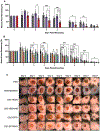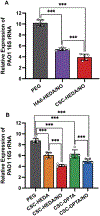Role of Nitric Oxide-Releasing Glycosaminoglycans in Wound Healing
- PMID: 35580341
- PMCID: PMC11574979
- DOI: 10.1021/acsbiomaterials.2c00392
Role of Nitric Oxide-Releasing Glycosaminoglycans in Wound Healing
Abstract
Two glycosaminoglycan (GAG) biopolymers, hyaluronic acid (HA) and chondroitin sulfate (CS), were chemically modified via carbodiimide chemistry to facilitate the loading and release of nitric oxide (NO) to develop a multi-action wound healing agent. The resulting NO-releasing GAGs released 0.2-0.9 μmol NO mg-1 GAG into simulated wound fluid with NO-release half-lives ranging from 20 to 110 min. GAGs containing alkylamines with terminal primary amines and displaying intermediate NO-release kinetics exhibited potent, broad spectrum bactericidal action against three strains each of Pseudomonas aeruginosa and Staphylococcus aureus ranging in antibiotic resistance profile. NO loading of the GAGs was also found to decrease murine TLR4 activation, suggesting that the therapeutic exhibits anti-inflammatory mechanisms. In vitro adhesion and proliferation assays utilizing human dermal fibroblasts and human epidermal keratinocytes displayed differences as a function of the GAG backbone, alkylamine identity, and NO-release properties. In combination with antibacterial properties, the adhesion and proliferation profiles of the GAG derivatives enabled the selection of the most promising wound healing candidates for subsequent in vivo studies. A P. aeruginosa-infected murine wound model revealed the benefits of CS over HA as a pro-wound healing NO donor scaffold, with benefits of accelerated wound closure and decreased bacterial burden attributable to both active NO release and the biopolymer backbone.
Keywords: antibacterial; chondroitin sulfate; hyaluronic acid; nitric oxide; wound healing.
Figures






Similar articles
-
Nitric Oxide-Releasing Hyaluronic Acid as an Antibacterial Agent for Wound Therapy.Biomacromolecules. 2021 Feb 8;22(2):867-879. doi: 10.1021/acs.biomac.0c01583. Epub 2020 Dec 29. Biomacromolecules. 2021. PMID: 33372774
-
Hyaluronan/collagen hydrogels containing sulfated hyaluronan improve wound healing by sustained release of heparin-binding EGF-like growth factor.Acta Biomater. 2019 Mar 1;86:135-147. doi: 10.1016/j.actbio.2019.01.029. Epub 2019 Jan 17. Acta Biomater. 2019. PMID: 30660005
-
Matrix glycosaminoglycans in the growth phase of fibroblasts: more of the story in wound healing.J Surg Res. 2000 Jul;92(1):45-52. doi: 10.1006/jsre.2000.5840. J Surg Res. 2000. PMID: 10864481
-
Nitric oxide-releasing poly(lactic-co-glycolic acid)-polyethylenimine nanoparticles for prolonged nitric oxide release, antibacterial efficacy, and in vivo wound healing activity.Int J Nanomedicine. 2015 Apr 22;10:3065-80. doi: 10.2147/IJN.S82199. eCollection 2015. Int J Nanomedicine. 2015. PMID: 25960648 Free PMC article.
-
Progress and Promise of Nitric Oxide-Releasing Platforms.Adv Sci (Weinh). 2018 Apr 23;5(6):1701043. doi: 10.1002/advs.201701043. eCollection 2018 Jun. Adv Sci (Weinh). 2018. PMID: 29938181 Free PMC article. Review.
Cited by
-
Biopolymeric Inhalable Dry Powders for Pulmonary Drug Delivery.Pharmaceuticals (Basel). 2024 Dec 4;17(12):1628. doi: 10.3390/ph17121628. Pharmaceuticals (Basel). 2024. PMID: 39770469 Free PMC article. Review.
-
Combination treatment to improve mucociliary transport of Pseudomonas aeruginosa biofilms.PLoS One. 2024 Feb 23;19(2):e0294120. doi: 10.1371/journal.pone.0294120. eCollection 2024. PLoS One. 2024. PMID: 38394229 Free PMC article.
-
Enhanced Bacterial-Infected Wound Healing by Nitric Oxide-Releasing Topological Supramolecular Nanocarriers with Self-Optimized Cooperative Multi-Point Anchoring.Adv Sci (Weinh). 2023 Apr;10(11):e2206959. doi: 10.1002/advs.202206959. Epub 2023 Feb 15. Adv Sci (Weinh). 2023. PMID: 36793143 Free PMC article.
-
Delivery of Nitric Oxide by Chondroitin Sulfate C Increases the Rate of Wound Healing through Immune Modulation.ACS Appl Bio Mater. 2024 Sep 16;7(9):6152-6161. doi: 10.1021/acsabm.4c00731. Epub 2024 Aug 19. ACS Appl Bio Mater. 2024. PMID: 39159191
-
Endothelial dysfunction: molecular mechanisms and clinical implications.MedComm (2020). 2024 Jul 22;5(8):e651. doi: 10.1002/mco2.651. eCollection 2024 Aug. MedComm (2020). 2024. PMID: 39040847 Free PMC article. Review.
References
-
- Stechmiller JK; Childress B; Cowan L Arginine Supplementation and Wound Healing. 2005, 52–61. - PubMed
Publication types
MeSH terms
Substances
Grants and funding
LinkOut - more resources
Full Text Sources
Other Literature Sources
Molecular Biology Databases
